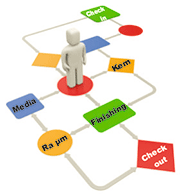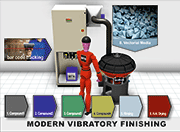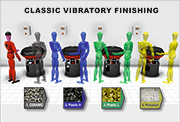E-Archive
Good Vibrations
in Vol. 17 - May Issue - Year 2016
Repeatability And Traceability



Traceability and repeatability are leading requirements for almost all workpieces or batches to be finished in the medical field, as well as in the aerospace, automotive, precision mechanical (i.e.: watch industry), and many other fields.
Everywhere ISO standards are applied, or even EN9100 standards quality systems are involved for the specific batches to be tracked, therefore the theme of traceability and repeatability becomes a priority.
To satisfy these needs for mass metal finishing processes as well as in precision material removal finishing tasks, it is not a complicated issue, although sometimes it could be quite complex.
In fact, it is complex when the quality statements and requirements foresee many variables to control before and/or after the finishing tasks, like:
• the list of items to be finished is long and dense of many different types and specs;
• items to be finished are associated with a wide range of finishing machines and accessories, media and compounds to be employed;
• processing specs are different depending on the kind of items;
• steps to follow in different machines are many, with different media and cycle times like rough finishing (with ceramic media), smoothing (with plastic media High cut), fine smoothing (with plastic media Fine cut), polishing (with porcelain media) - then parts have to be washed and/or dried;
• the combination of possible variable factors is wide, like:
- media classification (the operation to separate consumed media becoming too small after some hours of work);
- media integration to maintain same level into the processing bowl, media batch I.D. - when batch numbers are different, what to do? (Change all media and substitute with others of the new batch ?);
- Can media employed for titanium alloy be employed also for Inconel, or it is better to keep two batches of media separate, one for Titan and one for Inconel?
- Does the station have a tracking function to register the quantity of chemical compound dosed into each phase of finishing process?
- Is the water metering device reliable and able to meter the precise flow of water flowing to the machine?
- Is the water quality constant or its salinity changing all the time? - is this parameter checked (i.e. with a conductivimeter?) - which parameters, for example: mScm2 are allowed (min/max)?
- Is the operative temperature under control? Is it influencing the finishing process (Yes/Not)? How can the temperature of the process be kept under control?
- Are machine motor-vibrator frequencies always costant (how they are detected in time)?
- Is machine timer precise (is the time factor precise, controlled and/or calibrated periodically)?
- Is machine PLC software validated?
- Is disaster recovery backup of registered logs regularly checked?
- Are PLC communication devices (in/out) regularly checked?
- Is machine amplitude under control (how many times a year or per month is the amplitude checked)?
- Is machine lining consumed (how regularly is the lining thickness checked before the metal of the working bowl could risk contact with the workpieces)?
- Are the exhaust filter/filters of the machine regularly cleaned/inspected?
Good help to provide serious and intelligent support to the quality system is mainly coming from the following areas, part of the finishing environment:
1. Finishing Process work flow
2. Finishing Process operative instructions
3. Hardware (finishing machine and accessories) description
4. Hardware (finishing machine and accessories) list of periodic controls, set-up and check list
5. Mainboard (control board, network communication protocols, printer/bar code scanner) description
6. Mainboard (control board, network communication protocols, printer/bar code scanner) instructions
7. Software (data base number of recipes, operator identification protocol, process identification protocol, batch/workpiece identification protocol, alarms, input devices protocol, output devices protocol, log protocol) description
8. Software (data base number of recipes, operator identification protocol, process identification protocol, batch/workpiece identification protocol, alarms, input devices protocol, output devices protocol, log protocol) instruction
9. Human Resources training protocol and program for safety procedures
10. Human Resources training protocol and program for finishing process management procedures
11. Human Resources training protocol and program for ordinary maintenance
12. Human Resources training protocol and program for ordinary check-up and set-up of critical parameters
13. Disaster recovery strategy for data back-up and restore
14. Main Server for data and finishing logs storage and transmission/output
15. Software Certification
16. Tracking code preferences/strategy
Another interesting assistance could consist of simplifying the elements of a complex workflow of the finishing tasks, too many times composed of several steps, in several kinds of machines, as reproduced in the right picture:
In this example a batch of workpieces of the same type is finished passing through at least four (4) finishing steps like:
1) Rough grinding with ceramic media and suitable compound, i.e. for 9 hours in machine 1, then
2) workpieces are unloaded and transferred to the second machine, with high cut plastic media and suitable compound, i.e. for 6 hours, then
3) workpieces are unloaded and transferred to the third machine, with fine cut plastic media and suitable compound, i.e. for 5 hours, then
4) workpieces are unloaded and transferred to the machine number four, with porcelain media and suitable compound, i.e. for 4 hours
finally, the workpieces have to be dried or washed in ultrasonic tanks, then rinsed and dried again.
The modern vibratory finishing technology can help sometimes to simplify the above kinds of multiple finishing processes by using a suitable media technology combined with a correct engineering of the process technology, to provide a single cycle, fully automatic, with multiple steps.
Using a suitable "vectorial media" in fact with chemical compounds that can be automatically dosed by means of devices able to do the precise (and digital) metering, it is possible to perform an automatic cycle composed of several steps, as in the following picture:
In this case, the batch of pieces can be detected by a bar-code scanner, enabling the database of recipes to start the correct automatic cycle where:
an automatic dosing station provides the several compounds and water to be dosed, starting from a very abrasive type in step 1, then decreasing the metal removal rate step by step towards phases 2, 3 and 4.
Finally a rinsing followed by a dropping out and a Hot Air Drying could be feasible in several applications.
Operator intervention is also limited to assist the loading and unloading operations, with an interesting increase of efficiency.
Reducing the factor of human intervention, reduction of possible mistakes is therefore evident and tracking activity is simplified.
Modern software is able to integrate a preventive maintenance checklist and/or an automatic limitation of the use of the machine, in case some important periodic controls are not confirmed using the authorized inspector's password.
Good Vibrations
by Paolo Redaelli
Contributing Editor MFN and Rollwasch® Italiana S.p.a.
Tel. +39.0362.930 334
Fax +39.0362.931 440
E-mail: paolo@mfn.li



























